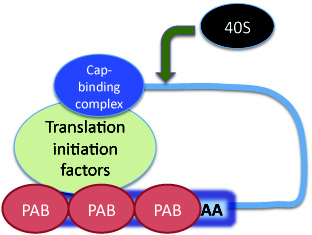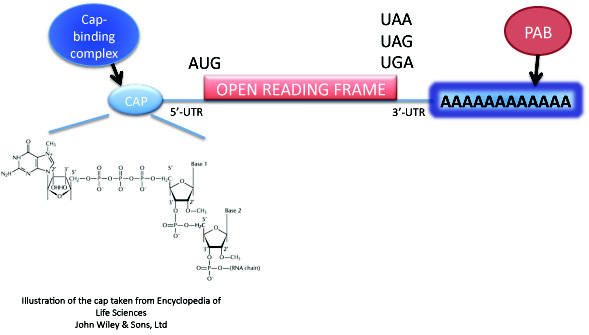From: Ploy(A) Tail
The Poly(A) Tail
As illustrated in the following figure, a generic
messenger RNA (mRNA) consists of a number of distinct features, each of
which has different functions. The very 5’-end* of the mRNA has a so-called cap (the chemical structure of which is shown in the figure). The
most recognizable part of the mRNA is the open-reading frame; this is
the series of nucleotides that are “read” by ribosomes to yield the
polypeptide that is coded by the mRNA. The open reading
frame begins (almost always) with the nucleotide triplet AUG, and ends
(after a number of nucleotides that is a multiple of three) with one of
the three “stop codons” (UAA, UAG, UGA). At the 3’-end* lies a tract of adenosines – between 90 and 300 or so, at the outset of the life of an mRNA. Finally,
the regions of the mRNA between the cap and open reading frame, and
between the open reading frame and poly(A) tail, are designated as the
5’- and 3’- untranslated regions, or UTRs.
These different features all interact with other
cellular factors; the complete story fills large review volumes, and I
won’t bother to try and describe everything. However, it is
important for this overview to note that the cap is bound by a
so-called cap-binding complex, and the poly(A) tail by a
poly(A)-specific RNA binding protein (the poly(A)-binding protein, or
PAB). As a single PAB binds only 12 or so nucleotides, the poly(A) tail is “coated” with a number of PAB subunits.
The poly(A) tail functions in two ways. It promotes translation of the mRNA by ribosomes, via a process that is briefly sketched in the following figure. The
poly(A) tail, via PAB, actually is “connected” with the cap of the
mRNA, via interactions of PAB and the cap-binding complex with other
translation initiation factors. This serves to circularize the mRNA-protein complex as shown, and to stabilize the interactions at the 5’-end of the mRNA. The
cap-binding complex and other translation initiation factors eventually
recruit the small (40S) ribosomal subunit to the vicinity of the cap;
this subunit and some of the initiation factors then scan along the mRNA
until it finds a suitable AUG triplet, whereupon the 60S ribosomal
subunit, initiator tRNAs, and other factors come into play to begin the
process of translation.


沒有留言:
張貼留言